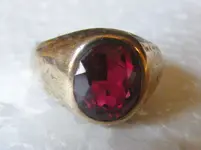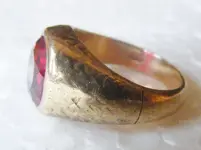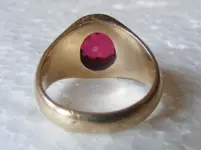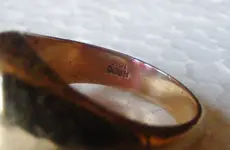You are using an out of date browser. It may not display this or other websites correctly.
You should upgrade or use an alternative browser.
You should upgrade or use an alternative browser.
Ruby Real or Fake?
- Thread starter CAllen
- Start date
Eu_citzen
Gold Member
Umm.. What? Ruby has directional hardness, but that's about it. Both synthetic and natural have this feature.
I don't think they can pack the atoms closer etc etc.
None of my reference books mention this, even if they could - would it still be ruby?
I imagine it would alter SG, hardness and RI.
Make glass harder then diamond? I think you need to get yourself some more reliable sources.
Sounds like it's bordering alchemy. :P
For starters I suggest Gemmology by Peter Read. A good book.
If cubics are harder.. Flourite, Sphalerite... I can probably find more soft minerals.
I don't think there is such a trend. At best the light passes through the crystal the same in all directions.
Many other minerals have one or more optic axis.
No, I haven't written a book. I've helped a friend out (silver smith) by writing a few short articles about different gems, treatments, synthetics etc. But that's about it. They are not publicly available.
Find me as in sending a PM?
I don't think they can pack the atoms closer etc etc.
None of my reference books mention this, even if they could - would it still be ruby?
I imagine it would alter SG, hardness and RI.
Make glass harder then diamond? I think you need to get yourself some more reliable sources.
Sounds like it's bordering alchemy. :P
For starters I suggest Gemmology by Peter Read. A good book.
If cubics are harder.. Flourite, Sphalerite... I can probably find more soft minerals.
I don't think there is such a trend. At best the light passes through the crystal the same in all directions.
Many other minerals have one or more optic axis.
No, I haven't written a book. I've helped a friend out (silver smith) by writing a few short articles about different gems, treatments, synthetics etc. But that's about it. They are not publicly available.
Find me as in sending a PM?
Upvote
0
Ya I'm more of a gold person. And I know when doing research one shouldn't rely one one source. But when man made vs genuin there is a simple test the pawn/jewelers do and I'm not 100% sure but I think that its hardness because of the uniform pattern of man made vs an irregular pattern. I saw a episode on discovery about it and they said when made a gems molecular structer dooes change and it showed a pic of both under a electron mocro and I saw the even pattern with my own eyes and tthey said because its even it makes it harder kinda like building a brick wall. If u do it with even pattern it will hold up bettter than just throwing it together with part even and part of it not. Plus genuine has more fracture points. They were mainly talking about diamonds but I thing they said it applies to all man made. And they said that they can manipulate how close the molecules are with temp, pressure etc. But I will do more research. I think I will do a simple google questions and see what is says about it because I'm sure u know more than I do about gems lol. But I always like a mental chalenge. That's how we grow our minds and learn more. Thx for keeping in touch. If u have any questions about gold I'm pretty up to speed with that lol. Have a good evening... Lonnie
Sent from my LGL75C using TreasureNet
Sent from my LGL75C using TreasureNet
Upvote
0
Well I just did some more reading on diamond made for the purpose of semi-conductor due to diamonds high tolerance to heat. And since I worked in the semi- conducter industry (siltec) I know what they are trying to do. Diamonds do not conduct elctricity but when u add boron and other secret element, that too can be manipulated. It stated they cannot use mined diamonds because no 2 diamonds are the same were as man made are near perfectly identical. And yes glass is the same. Have u ever wondered why they make bullet proof glass and not diamond? And with modern tech diamonds now can be made very cheap. It also talked about heat and pressure dictating the hardness etc.. so if ur information says anything different then u should maybe try some new sources because I doubt discovery and one of the leading diamond makers(liniers I think) out of boston, are both wrong. They don't go into complete detail because its very secretive but they explaine the basics. And if man made and genuine were identical they would not be able to test them and every pawn shop I've been to have a simple tool the tells them if man made cubic or genuin. I think that fact alone proves that they are not identical. It even said that the chances of having 3 nearly identical genuine diamons are the same as flipping a coin 10,000 time and always getting heads
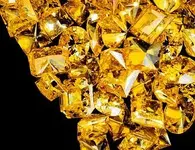
lol. So in short- genuine are all different and cubis are all the same and that's how they tell diference. Try googling "pics of diamonds under EM" and u can see it with your own eyes the diff. I hope I was helpful and gave u some insight on the matter. But don't take my word for it and read up on new ways they grow diamonds. I did download a pic of a pile of man made yellow that are for 1 all near identical and 2nd there is no way that many yellow diamonds (that are all the same) could be found in a mine.
Sent from my LGL75C using TreasureNet

lol. So in short- genuine are all different and cubis are all the same and that's how they tell diference. Try googling "pics of diamonds under EM" and u can see it with your own eyes the diff. I hope I was helpful and gave u some insight on the matter. But don't take my word for it and read up on new ways they grow diamonds. I did download a pic of a pile of man made yellow that are for 1 all near identical and 2nd there is no way that many yellow diamonds (that are all the same) could be found in a mine.
Sent from my LGL75C using TreasureNet
Upvote
0
Eu_citzen
Gold Member
I also started out as a gold prospector. 
The atom pattern of man-made vs natural is the same. Perhaps a bit generalized, but I'm not to bothered by those tiny differences since I can't measure/compare them myself.
It is nothing the general gemmologist will take into account either.
Take a look below for a feeling of what a gemmologist will look at:
Verneuil Synthetic Corundum: Dangerous Curves
Following the Silk Road: Rutile in Corundum
I think I see it out of a different perspective, and I sorta get confused I'm not sure I follow what you are talking about.
So I say in advance it may be possible misunderstandings here and there. :P
As for diamonds, they are nothing more then grinding media IMO. :P
I think they want to use the diamonds to conduct heat, which they willingly do?
I know why, diamond is brittle. But so is glass. If you ever have worked with Lexan it's more plastic like then glass.
It's used as bullet proof glass I want to recall.
Having diffuclt to grasp the whole context.
Rre they just generally talking about the polymorfs of carbon? (they would be correct in that case)
Another possiblity, they might be referring to using polycrystalline diamonds? They appear harder, but really aren't.
Diamonds hardness varies with different directions. That's why diamonds can grind/polish diamonds.
Polycrystalline diamonds are sorta like a piece of sugar (those for coffee) several diamond grains form a mass.
The orientation of the grains differ, making it a more aggressive grinding media. It appears harder.
I know this from my own experience, since I use synthetic diamond as a grinding media for my gems I cut.
If you want to read up on diamonds in general, try this:
http://www.gemologyproject.com/wiki/index.php?title=Diamond
Suprinsingly up to date as well.
I am also not sure what you mean with "cubic"?
If you are referring to Cubic Zirconia, an imitation of diamond. It's only supposed to look like diamond.
Already the SG will make sure you can "feel" it isn't likely a diamond. (if it is a loose stone)
Synthetic cubic zirconia - The Gemology Project

The atom pattern of man-made vs natural is the same. Perhaps a bit generalized, but I'm not to bothered by those tiny differences since I can't measure/compare them myself.
It is nothing the general gemmologist will take into account either.
Take a look below for a feeling of what a gemmologist will look at:
Verneuil Synthetic Corundum: Dangerous Curves
Following the Silk Road: Rutile in Corundum
I think I see it out of a different perspective, and I sorta get confused I'm not sure I follow what you are talking about.
So I say in advance it may be possible misunderstandings here and there. :P
As for diamonds, they are nothing more then grinding media IMO. :P
I think they want to use the diamonds to conduct heat, which they willingly do?
I know why, diamond is brittle. But so is glass. If you ever have worked with Lexan it's more plastic like then glass.

It's used as bullet proof glass I want to recall.
Having diffuclt to grasp the whole context.
Rre they just generally talking about the polymorfs of carbon? (they would be correct in that case)
Another possiblity, they might be referring to using polycrystalline diamonds? They appear harder, but really aren't.
Diamonds hardness varies with different directions. That's why diamonds can grind/polish diamonds.
Polycrystalline diamonds are sorta like a piece of sugar (those for coffee) several diamond grains form a mass.
The orientation of the grains differ, making it a more aggressive grinding media. It appears harder.
I know this from my own experience, since I use synthetic diamond as a grinding media for my gems I cut.
If you want to read up on diamonds in general, try this:
http://www.gemologyproject.com/wiki/index.php?title=Diamond
Suprinsingly up to date as well.
I am also not sure what you mean with "cubic"?
If you are referring to Cubic Zirconia, an imitation of diamond. It's only supposed to look like diamond.
Already the SG will make sure you can "feel" it isn't likely a diamond. (if it is a loose stone)

Synthetic cubic zirconia - The Gemology Project
Upvote
0
Ya I think were both correct. The piece I read was refering to the use of diamonds to replace the waffer(simi-conductor) which is used to make computer chips. The current silicon waffer is great but heat is the only real problem. It said diamonds can handle the heat but do not conduct electricity so they add boron etc to transform it into a semi-conductor.
its just amazing the advances of technology and the many used of things like dimonds by manipulating the compound by recreating artificial heat, pressure etc. And they keep so much of "how they do it" secret that I now can see how 2 ppl can look at the same thing differently lol. So I kinda understand what u mean but I'm still learning. I think the links u provided will help me better understand the whole picture. I will let u know if I have any questions about the content. Thanks for the insite... lonnie
Sent from my LGL75C using TreasureNet
its just amazing the advances of technology and the many used of things like dimonds by manipulating the compound by recreating artificial heat, pressure etc. And they keep so much of "how they do it" secret that I now can see how 2 ppl can look at the same thing differently lol. So I kinda understand what u mean but I'm still learning. I think the links u provided will help me better understand the whole picture. I will let u know if I have any questions about the content. Thanks for the insite... lonnie
Sent from my LGL75C using TreasureNet
Upvote
0
Similar threads
- Replies
- 1
- Views
- 188
- Replies
- 20
- Views
- 2K
Users who are viewing this thread
Total: 1 (members: 0, guests: 1)

